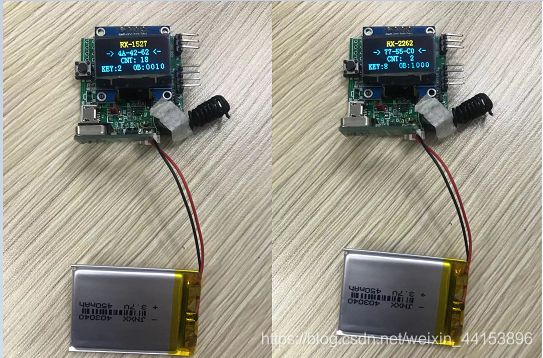精简版的sprintf
1.先说一下为什么要封装这个精简版的sprintf。是在做一个RF解码器时,使用到IIC的oled屏,使用到C库的sprintf。小用量的单片机(现在用到的单片机是STM8S003F3)一调用C库的sprintf,rom的容量直接满了......所以有了这个精简版的sprintf。嵌入式用到的地方还挺多的,收藏一下吧。废话不多说,上代码。
2.sprintf.c
//#include
#include
#define PADDING_RIGHT 1
#define PADDING_ZERO 2
#define PRINTI_BUF_LEN 12 //for 32bit signed integer
static int print2(char **out, int ch)
{
int count = 1;
if(ch == '\n')
count += print2(out, '\r');
if(out)
*(*out)++ = ch;
else
putchar(ch);
return count;
}
static int prints2(char **out, const char *str, int width, int pad)
{
int count = 0, padChar = ' ';
if(width > 0)
{
int len = 0;
const char *ptr;
for(ptr = str; *ptr; ++ptr)
len++;
if(len >= width)
width = 0;
else
width -= len;
if(pad & PADDING_ZERO)
padChar = '0';
}
if(!(pad & PADDING_RIGHT))
{
for(; width > 0; width--)
{
count += print2(out, padChar);
}
}
while(*str)
{
count += print2(out, *str++);
}
while(width--)
{
count += print2(out, padChar);
}
return count;
}
static int printi2(char **out, int val, int base, int sign, int width, int pad, int alphaBase)
{
char buf[PRINTI_BUF_LEN];
char *ptr;
int t, neg = 0, count = 0;
unsigned int uval = (unsigned int)val;
if(val == 0)
{
buf[0] = '0';
buf[1] = '\0';
return prints2(out, buf, width, pad);
}
if(sign && base == 10 && val < 0)
{
neg = 1;
uval = (unsigned int)-val;
}
ptr = buf + PRINTI_BUF_LEN - 1;
*ptr = '\0';
while(uval)
{
t = uval % base;
if(t >= 10)
t += alphaBase - '0' - 10;
*--ptr = t + '0';
uval /= base;
}
if(neg)
{
if(width && (pad & PADDING_ZERO))
{
count += print2(out, '-');
width--;
}
else
{
*--ptr = '-';
}
}
return count + prints2(out, ptr, width, pad);
}
static int vprintf2(char **out, const char *fmt, va_list args)
{
int count = 0;
while(*fmt)
{
if(*fmt == '%')
{
int width = 0, pad = 0;
int type;
char *str, tmp[2];
fmt++;
if(!*fmt)
break;
if(*fmt == '%')
goto _out;
if(*fmt == '-')
{
pad = PADDING_RIGHT;
fmt++;
}
if(*fmt == '0')
{
pad = PADDING_ZERO;
fmt++;
}
for(; *fmt >= '0' && *fmt <= '9'; fmt++)
width = width * 10 + *fmt - '0';
type = *fmt;
switch(type)
{
case 's':
str = va_arg(args, char *);
str = str ? str : "(null)";
count += prints2(out, str, width, pad);
break;
case 'd':
count += printi2(out, va_arg(args, int), 10, 1, width, pad, 0);
break;
case 'u':
count += printi2(out, va_arg(args, int), 10, 0, width, pad, 0);
break;
case 'x':
count += printi2(out, va_arg(args, int), 16, 0, width, pad, 'a');
break;
case 'p':
count += prints2(out, "0x", 0, 0);
width = 8;
pad = PADDING_ZERO;
case 'X':
count += printi2(out, va_arg(args, int), 16, 0, width, pad, 'A');
break;
case 'c':
tmp[0] = (char)va_arg(args, int);
tmp[1] = 0;
count += prints2(out, tmp, width, pad);
break;
}
}
else
{
_out:
count += print2(out, *fmt);
}
fmt++;
}
if(out)
**out = '\0';
va_end(args);
return count;
}
int printf2(const char *fmt, ...)
{
va_list va;
va_start(va, fmt);
return vprintf2(0, fmt, va);
}
int sprintf2(char *buf, const char *fmt, ...)
{
va_list va;
va_start(va, fmt);
return vprintf2(&buf, fmt, va);
}
3.sprintf.h
#ifndef __SPRINTF_H
#define __SPRINTF_H
#include
#include
extern int putchar(int ch);
static int print2(char **out, int ch);
static int prints2(char **out, const char *str, int width, int pad);
static int printi2(char **out, int val, int base, int sign, int width, int pad, int alphaBase);
static int vprintf2(char **out, const char *fmt, va_list args);
int printf2(const char *fmt, ...);
int sprintf2(char *buf, const char *fmt, ...);
#endif
4.最后上一下解码器的效果。
